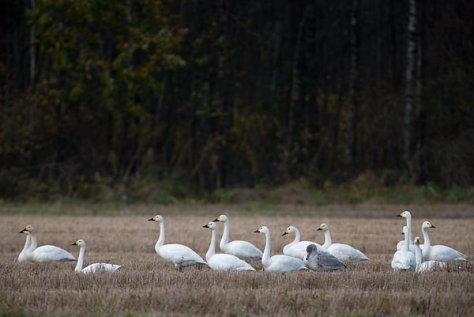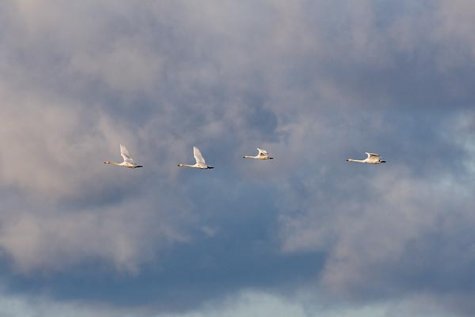Swan autumn
Photos: Arne Ader
Translation: Liis
Whooper swans and Bewick’s swans. Matsalu
Bewick's swan Väikeluik Cygnus columbianus ssp. bewickii
Whooper swan Laululuik Cygnus cygnus
Mid-October is the period when on average over the years the swans that breed on the tundra reach Estonia on their migration. They leave along with the month of November – swans go, snow at back is an Estonian saying. The actual number of the few winterers depends on ice conditions in the coastal sea. Important stopping places on migration are the bays of Matsalu and Haapsalu, the Silma nature reserve area, Väike väin, the Käina bay, Audru polder, Gulf of Riga (Pärnu laht), and at Lake Peipus the Kallaste-Mustvee shore, Lake Lahepera ...
In the autumn migration Bewick’s swans are more numerous than whooper swans: more than twenty thousand, and up to ten thousand magnificent birds respectively. On migration whooper swans fly very high – a flight altitude of over 8 kilometres has been recorded on migration; there the air temperature is – 40 degrees. Flight image is linear, with slow and heavy wingbeats, the low-pitched noise from the wings is audible far off. On landing as well as taking off a long “runway“ is needed. The call of whooper swans is a loud and far-reaching hooting. We see whooper swans busy in groups at water bodies, swimming or standing in the water.
Whooper swans and the mute swans familiar to all are similar in size, wingspan more than 2 metres. Whooper swans don’t bend their necks nor do they raise and fluff up their wings as mute swans do. The Finnish national bird has a sleek silhouette, holding its neck straight. The base of the beak of adults is broadly yellow, tip black – the base of the beak of young birds is pinkish and the plumage brownish grey.
Now about the smaller relative that arrives here a little later after having nested in the Arctic tundra – the Bewick’s swan. Until departure they often keep company with and feed together with whooper swans. Studying a mixed flock we realise that we have to do with a somewhat smaller bird than the whooper swan. There is less yellow at the beak base; the beak seems black seen from a distance.
They feed on aquatic plants which they can get at in water depths of up to 60 centimetres, mostly Potamogeton pondweeds (P. perfoliatus, P. pectinatus), but also Chara algae. If natural food in water bodies should become scarce they move to wet or waterlogged grain fields to feed on corn sprouts or spilled grain – preferring barley, wheat, oats or grain sprouts. Compared to aquatic plants the nutritional value of those mentioned is not smaller.
On the grain fields of Matsalu Bewick’s swans were first seen in 1978. In the wintering areas - the Netherlands and Germany - sugar beets and potatoes are preferred in the fields.
There are two waves in the autumn migration of Bewick’s swans: young non-breeding birds move in the first, in the second adult birds along with this year’s young birds.
Bewick’s swan observations: LINK
Whooper swan observations: LINK
Swans










